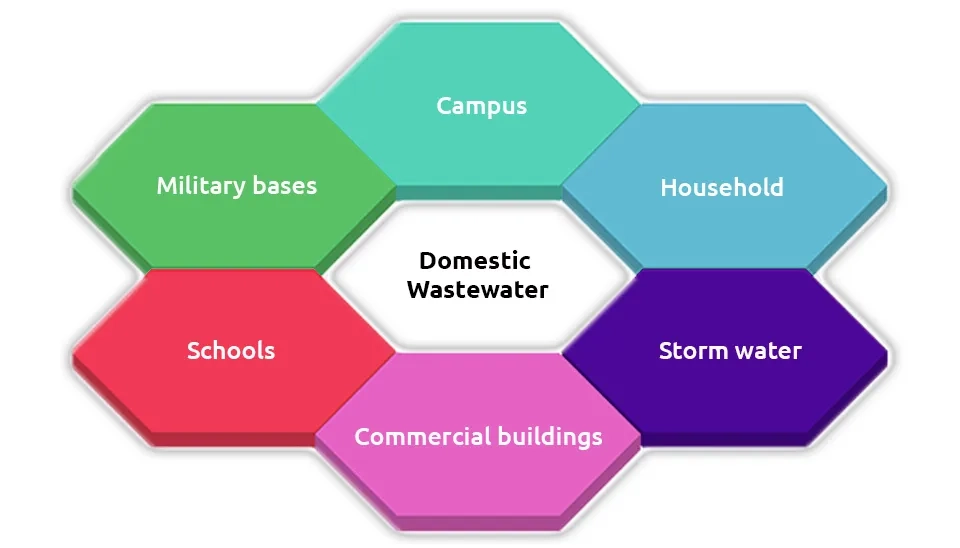
380 billion cubic meters of domestic wastewater are generated globally in one year. It is estimated that this number will increase by 24 and 51% in 2030 and 2050 respectively. Based on UN Water, high-income countries treat about 70% of the wastewater they generate. In the upper middle- and lower-income countries this ratio is reduced to 38% and 28% respectively. And this number for low-income countries is only 8% (Environment and Natural Resources Department, 2022).
It is essential to understand the nature of wastewater for further management actions such as an efficient and cost-effective design and operation of municipal wastewater treatment plants and sewerage systems, etc. In this. paper we are going to introduce the physical, chemical, and biological characteristics of domestic wastewater, its sources, and the most important parameters that define it.

1. What is Domestic Wastewater?
Generally, wastewater is categorized into two groups: Domestic Wastewater (DW) and Industrial Wastewater (IW). Presents of high molecular weight substances which are discharged from residential waste pollute the water and produce domestic wastewater having an odor, color, taste, etc (Dhulap and Chavan 2012). DW is mainly a product of household activities. The major difference between domestic and industrial wastewater is in the amount of Biochemical Oxygen Demand (BOD), Chemical Oxygen Demand (COD), potential Hydrogen (pH), color, and heavy metals. Regularly, BOD in DW is higher than IW but COD and heavy metal’s concentration is high in IW. The quality and quantity of domestic wastewater is predictable. A wide range of inorganic and organic pollutants as well as pathogens, such as bacteria and viruses which may cause waterborne illnesses, are present in domestic sewage.
2. Source of Municipal Wastewater
As it is mentioned, the primary source of domestic wastewater is households which consist of 25 % blackwater, which comprises water from the closet, and 75% greywater (also referred to as sullage), which includes all the remaining household wastewater, such as bath, laundry and from other uses of human waste, are found in raw sewage (Phonvisai et al., 2006). Furthermore, effluent from schools, military bases, camps, business and commercial centers, and also, surface and ground waters collected by sewerage systems are other sources that are included in this category.

3. Characteristics of Domestic Wastewater
Recognizing the characteristics of wastewater is an acceptable way to distinguish domestic wastewater from industrial wastewater. Quality of municipal sewage is dependent on population, age rate, lifestyle, living standards, and cultural habits (Lettinga et al., 1993).

3.1. Physical Characteristics
Color: the color of domestic wastewater manifests its age. fresh wastewater is commonly gray and by the time it is changing to black.
Odor: decomposition of organic matter in wastewater produces gasses which is the main reason for odors in DW. By anaerobic activity of microorganisms, hydrogen sulfide will degrade and sulfate reduces to sulfides. This is a source of the special odor of wastewater. odor is one of the most important factors in locating sewage treatment plants.
Solids: Whole matter which remains as residual at 105° C is defined as total solids. Total lids can be divided into Total Suspended Solids (TSS) and Volatile Suspended Solids (VSS). Normal concentrations of TSS are illustrated in the table below.
Temperature: The average temperature of DW depends on location and varies from (10° to 27° C). Temperature affects chemical and biological reaction rate and oxygen solubility. as a result, it's an important characteristic of DW. On one hand, high temperature leads to a rise in the growth of planktonic species. On the other hand, low temperatures limit sewage treatment processes and will increase detention time and plant size (Muttamara 1996).
3.2. Chemical Characteristics of Domestic Wastewater
The chemistry of DW illustrates 70% of organics and 30% of inorganic compounds and gasses which 85 to 90% of inorganics and 55-60% of organic materials are dissolved in wastewater.
Organic materials: Organic matters can be defined as any composition of oxygen, hydrogen, carbon, and in some cases nitrogen. These compounds make a group of organics in domestic wastewater including carbohydrates (25 to 50%), grease and oil (10%), and protein (40 to 60%). And definitely, urea is another organic found in municipal wastewater.
Inorganic materials: Some of the common inorganic materials that can be found in domestic sewage are alkalinity causing compounds, nitrogen, phosphorus, sulfur, chloride and hydrogen ions. Concentration of these compounds in different parts of the world are shown in the table below.
Gasses: Oxygen, nitrogen, carbon dioxide, hydrogen sulfide, ammonia, and methane are the main gasses in municipal sewage. Among gasses named before, oxygen, methane, and hydrogen sulfide have gotten more attention and are effective parameters in the design of municipal wastewater treatment plants (Al-Mawla et al., 2023).
Table 1. Main contaminants in residential sewage by location (Tjandraatmadja and Diaper 2006)
main-contaminants-residential-sewage-by-location
3.3. Biological Characteristics of Municipal Wastewater
Bacteria, protozoa, and viruses must be viewed in the influent and effluent of wastewater treatment plants. Their entrance to water bodies causes water-borne illnesses in humans and animals. In raw wastewater, fecal coliform concentrations typically range from a limited hundred thousand to tens of millions per 100 ml of the sample ( Pant & Adholeya 2007)
Table 2. Main microorganisms found in domestic wastewater and their disease (Sperling 2007)
main-microorganisms-domestic-wastewater-disease
4. Main Parameters of Domestic Wastewater
There are several parameters indicating organic and inorganic materials, pathogens, gasses, etc. in wastewater. Here are some of the main wastewater parameters.
BOD: The amount of oxygen required to stabilize carbonaceous organic matter through biochemical processes is calculated by the BOD. The objective is that the biological breakdown of organic matter in a given volume of wastewater shall be ensured at an appropriate time (36-04). The standard BOD 5 test shows How much oxygen was depleted in a sample for five days.
COD: The quantity of oxygen essential to oxidize organic materials is shown by COD. COD can be measured by a COD reactor and photometer.
TSS: Substances such as inorganic and organic materials which are not dissolved in wastewater are named TSS. In order to measure TSS, non-filterable samples evaporate and the residue will be TSS.
pH: pH illustrates the acidity and alkalinity of wastewater which is the concentration of hydrogen ions in wastewater.
Total Phosphorus (TP) and Total Nitrogen (TN): represent all nutrients in domestic wastewater that cause algal bloom in wastewater.
Oil and Grease (O&G): O&G is a parameter to demonstrate the concentration of oils, fats, and fatty acids in sewage (Sperling 2007) .
Table. the common concentration of domestic wastewater parameters ( Muttamara 1996, Yasir M. Al-Mawla et al., 2023)
domestic-wastewater-parameter-concentration-table
5. Conclusion
Domestic wastewater is one of the most important water problem issues in lots of countries. Having information about its characteristics and the amount of DW production leads us to the appropriate design of municipal wastewater treatment and sewage networks.
This article describes domestic wastewater and its characteristics. Normal ranges of BOD, COD, TSS, pH, etc. are illustrated which are 200, 400, 250, and 7 respectively. These normal concentrations vary in different locations and they can not be used as a reference for sewage treatment plant design. Moreover, pathogens present in municipal wastewater and the importance of pathogens removal are discussed. Finally, by reading this article, you will be able to distinguish domestic wastewater and take further steps for managing wastewater-related problems.
